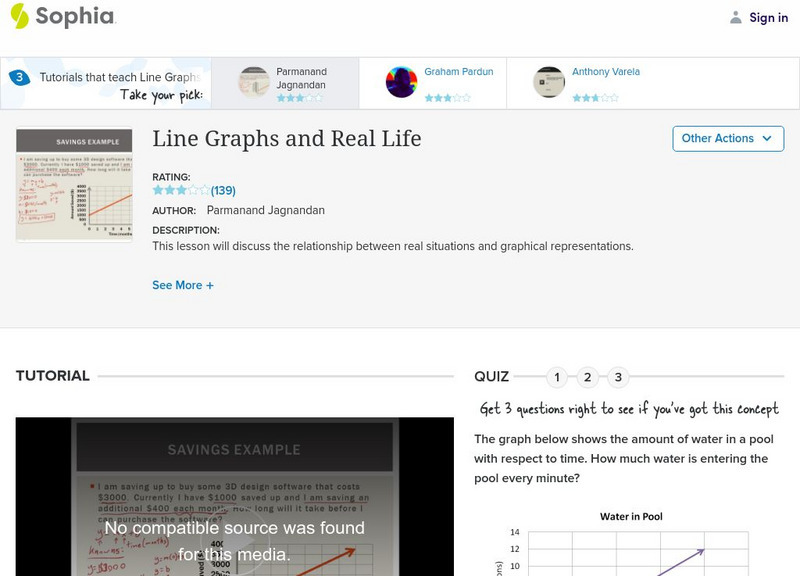Hi, what do you want to do?
Curated Video
How Transportation Developed Cities and Industries
Dr. Forrester talks about how transportation, such as the Wells Fargo stagecoach, influenced the development of cities and industries in the western region.
Curated Video
Measurement Line Plots
Mr. Addit explains line plots and how to read information displayed on them.
Curated Video
Exploring Vertical Translations of Linear Equations
In this lesson, students will learn about vertical translations of linear equations. They will explore how these translations affect the graph and algebraic representation of the equations. By understanding the similarities and...
Curated Video
KS2 Primary Maths Age 9-13 - Statistics: Line Graphs - Explained
SchoolOnline's Primary Maths videos are brilliant, bite-size tutorial videos delivered by examiners. Ideal for ages 9-13, they cover every key topic and sub topic covered in Maths in clear and easy to follow steps. This video looks at...
Curated Video
Analysing Data in Line Graphs
This video shows the process for solving the problem presented in SATs 2022 Paper 2 Q13, which involves analyzing data presented in line graphs. Students will learn how to read a line graph and analyze the data presented within it. They...
Curated Video
Interpreting Line Graphs: Understanding Scales
In this lesson, students will learn how to read and interpret line graphs by understanding the scales. They will understand the importance of considering units and scaling when analyzing graphs. By analyzing the slope of the graph,...
Corbett Maths
Frequency Polygons
How many ways can you think of to display data? A quick video lesson describes the process of creating one of them, a line graph, which is also referred to as a frequency polygon. After creating the graph, the instructor models how to...
Corbett Maths
Drawing Cumulative Frequency Graphs
What's the difference between frequency and cumulative frequency? Young scholars consider the question as they create a cumulative frequency graph. They watch as the frequency totals grow to create a new shape of the graph.
Corbett Maths
Drawing Conversion Graphs
A conversion graph makes quick work of determining unit conversions. A video lesson demonstrates how to create and use a conversion graph. Learners then demonstrate their understanding with provided practice problems.
Corbett Maths
Line Graphs
Here's a lesson sure to keep classes in line! A straight-to-the-point video explains the steps of creating a line graph from a table of data. Following the video, learners have plenty of opportunities to practice with the included...
Mathed Up!
Frequency Polygons
Frequency polygons are a different way to represent frequencies over intervals. Pupils take frequencies for intervals of data from a frequency table and plot them as a frequency polygon. Budding mathematicians find information about the...
Bozeman Science
Beginner's Guide to Graphing Data
A graph is a graph is a graph. This video reviews different types of graphs (line, bar, circle, histogram, scatter plot) using a matching game. It also describes the purpose of each type of graph to help learners remember when to use...
Curated OER
How Do You Graph the Union of Two Inequalities?
Two given inequalities and you need to find the union. What is the union? Well, it just means that you need to show the graphs of the given inequalities on the same number line. Keep in mind, less than, greater than, and equal to, and...
Curated OER
How Do You Graph the Union of Two Inequalities?
Two given inequalities and you need to find the union. What is the union? Well, it just means that you need to show the graphs of the given inequalities on the same number line. Keep in mind, less than, greater than, and equal to, and...
Curated OER
Line Graphs - Math Help
Learners won't have a hard time reading the data on a line graph after viewing this comprehensive video clip. The tutor speaks slowly and clearly so that learners will be able to follow along as she answers a two-part question with data...
Virtual Nerd
Virtual Nerd: How Do You Use a Line Graph to Make Predictions?
Can you use a line graph to make predictions? Watch and see how this can be done! [3:37]
Virtual Nerd
Virtual Nerd: What Is a Line Graph?
A line graph is one of many ways we can visually represent data. Watch this tutorial for examples. [4:05]
Khan Academy
Khan Academy: Statistics: Reading Line Graphs
Video demonstration of interpreting line graphs in order to answer a question. [2:20]
Sophia Learning
Sophia: Line Graphs and Real Life
This video lesson demonstrates how to create a line graph to solve two real world math problems.
Study Pug
Study Pug: Advantages and Disadvantages of Different Graphs
This lesson discusses the advantages and disadvantages of using different types of graphs to display data, such as pictographs, line graphs, and bar graphs. [3:08]
Loyola University Chicago
Math Flix: Graphs: Pictogram, Bar Graph & Line Graph
This QuickTime movie provides examples of pictograms, bar graph, and line graph. A pdf worksheet is available by clicking on the hyperlink at the bottom of the page. As you watch and listen to the teacher and student interact it helps...
Loyola University Chicago
Math Flix: Graphs: Matching Stories to Graphs Part 2
This QuickTime movie provides more opportunities to match stories to graphs. As you watch and listen to the teacher and student interact it helps clarify the thinking behind applying this concept.





















